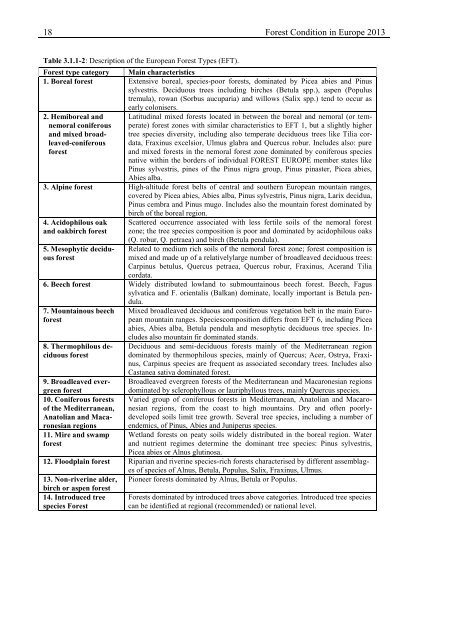Forest Condition in Europe - ICP Forests
Forest Condition in Europe - ICP Forests
Forest Condition in Europe - ICP Forests
You also want an ePaper? Increase the reach of your titles
YUMPU automatically turns print PDFs into web optimized ePapers that Google loves.
18 <strong>Forest</strong> <strong>Condition</strong> <strong>in</strong> <strong>Europe</strong> 2013<br />
Table 3.1.1-2: Description of the <strong>Europe</strong>an <strong>Forest</strong> Types (EFT).<br />
<strong>Forest</strong> type category Ma<strong>in</strong> characteristics<br />
1. Boreal forest Extensive boreal, species-poor forests, dom<strong>in</strong>ated by Picea abies and P<strong>in</strong>us<br />
sylvestris. Deciduous trees <strong>in</strong>clud<strong>in</strong>g birches (Betula spp.), aspen (Populus<br />
tremula), rowan (Sorbus aucuparia) and willows (Salix spp.) tend to occur as<br />
early colonisers.<br />
2. Hemiboreal and<br />
nemoral coniferous<br />
and mixed broadleaved-coniferous<br />
forest<br />
Latitud<strong>in</strong>al mixed forests located <strong>in</strong> between the boreal and nemoral (or temperate)<br />
forest zones with similar characteristics to EFT 1, but a slightly higher<br />
tree species diversity, <strong>in</strong>clud<strong>in</strong>g also temperate deciduous trees like Tilia cordata,<br />
Frax<strong>in</strong>us excelsior, Ulmus glabra and Quercus robur. Includes also: pure<br />
and mixed forests <strong>in</strong> the nemoral forest zone dom<strong>in</strong>ated by coniferous species<br />
native with<strong>in</strong> the borders of <strong>in</strong>dividual FOREST EUROPE member states like<br />
P<strong>in</strong>us sylvestris, p<strong>in</strong>es of the P<strong>in</strong>us nigra group, P<strong>in</strong>us p<strong>in</strong>aster, Picea abies,<br />
Abies alba.<br />
3. Alp<strong>in</strong>e forest High-altitude forest belts of central and southern <strong>Europe</strong>an mounta<strong>in</strong> ranges,<br />
covered by Picea abies, Abies alba, P<strong>in</strong>us sylvestris, P<strong>in</strong>us nigra, Larix decidua,<br />
P<strong>in</strong>us cembra and P<strong>in</strong>us mugo. Includes also the mounta<strong>in</strong> forest dom<strong>in</strong>ated by<br />
birch of the boreal region.<br />
4. Acidophilous oak<br />
and oakbirch forest<br />
5. Mesophytic deciduous<br />
forest<br />
Scattered occurrence associated with less fertile soils of the nemoral forest<br />
zone; the tree species composition is poor and dom<strong>in</strong>ated by acidophilous oaks<br />
(Q. robur, Q. petraea) and birch (Betula pendula).<br />
Related to medium rich soils of the nemoral forest zone; forest composition is<br />
mixed and made up of a relativelylarge number of broadleaved deciduous trees:<br />
Carp<strong>in</strong>us betulus, Quercus petraea, Quercus robur, Frax<strong>in</strong>us, Acerand Tilia<br />
cordata.<br />
6. Beech forest Widely distributed lowland to submounta<strong>in</strong>ous beech forest. Beech, Fagus<br />
sylvatica and F. orientalis (Balkan) dom<strong>in</strong>ate, locally important is Betula pendula.<br />
7. Mounta<strong>in</strong>ous beech<br />
forest<br />
8. Thermophilous deciduous<br />
forest<br />
9. Broadleaved evergreen<br />
forest<br />
10. Coniferous forests<br />
of the Mediterranean,<br />
Anatolian and Macaronesian<br />
regions<br />
11. Mire and swamp<br />
forest<br />
Mixed broadleaved deciduous and coniferous vegetation belt <strong>in</strong> the ma<strong>in</strong> <strong>Europe</strong>an<br />
mounta<strong>in</strong> ranges. Speciescomposition differs from EFT 6, <strong>in</strong>clud<strong>in</strong>g Picea<br />
abies, Abies alba, Betula pendula and mesophytic deciduous tree species. Includes<br />
also mounta<strong>in</strong> fir dom<strong>in</strong>ated stands.<br />
Deciduous and semi-deciduous forests ma<strong>in</strong>ly of the Mediterranean region<br />
dom<strong>in</strong>ated by thermophilous species, ma<strong>in</strong>ly of Quercus; Acer, Ostrya, Frax<strong>in</strong>us,<br />
Carp<strong>in</strong>us species are frequent as associated secondary trees. Includes also<br />
Castanea sativa dom<strong>in</strong>ated forest.<br />
Broadleaved evergreen forests of the Mediterranean and Macaronesian regions<br />
dom<strong>in</strong>ated by sclerophyllous or lauriphyllous trees, ma<strong>in</strong>ly Quercus species.<br />
Varied group of coniferous forests <strong>in</strong> Mediterranean, Anatolian and Macaronesian<br />
regions, from the coast to high mounta<strong>in</strong>s. Dry and often poorlydeveloped<br />
soils limit tree growth. Several tree species, <strong>in</strong>clud<strong>in</strong>g a number of<br />
endemics, of P<strong>in</strong>us, Abies and Juniperus species.<br />
13. Non-river<strong>in</strong>e alder,<br />
birch or aspen forest<br />
14. Introduced tree<br />
species <strong>Forest</strong><br />
Wetland forests on peaty soils widely distributed <strong>in</strong> the boreal region. Water<br />
and nutrient regimes determ<strong>in</strong>e the dom<strong>in</strong>ant tree species: P<strong>in</strong>us sylvestris,<br />
Picea abies or Alnus glut<strong>in</strong>osa.<br />
12. Floodpla<strong>in</strong> forest Riparian and river<strong>in</strong>e species-rich forests characterised by different assemblages<br />
of species of Alnus, Betula, Populus, Salix, Frax<strong>in</strong>us, Ulmus.<br />
Pioneer forests dom<strong>in</strong>ated by Alnus, Betula or Populus.<br />
<strong>Forest</strong>s dom<strong>in</strong>ated by <strong>in</strong>troduced trees above categories. Introduced tree species<br />
can be identified at regional (recommended) or national level.
















